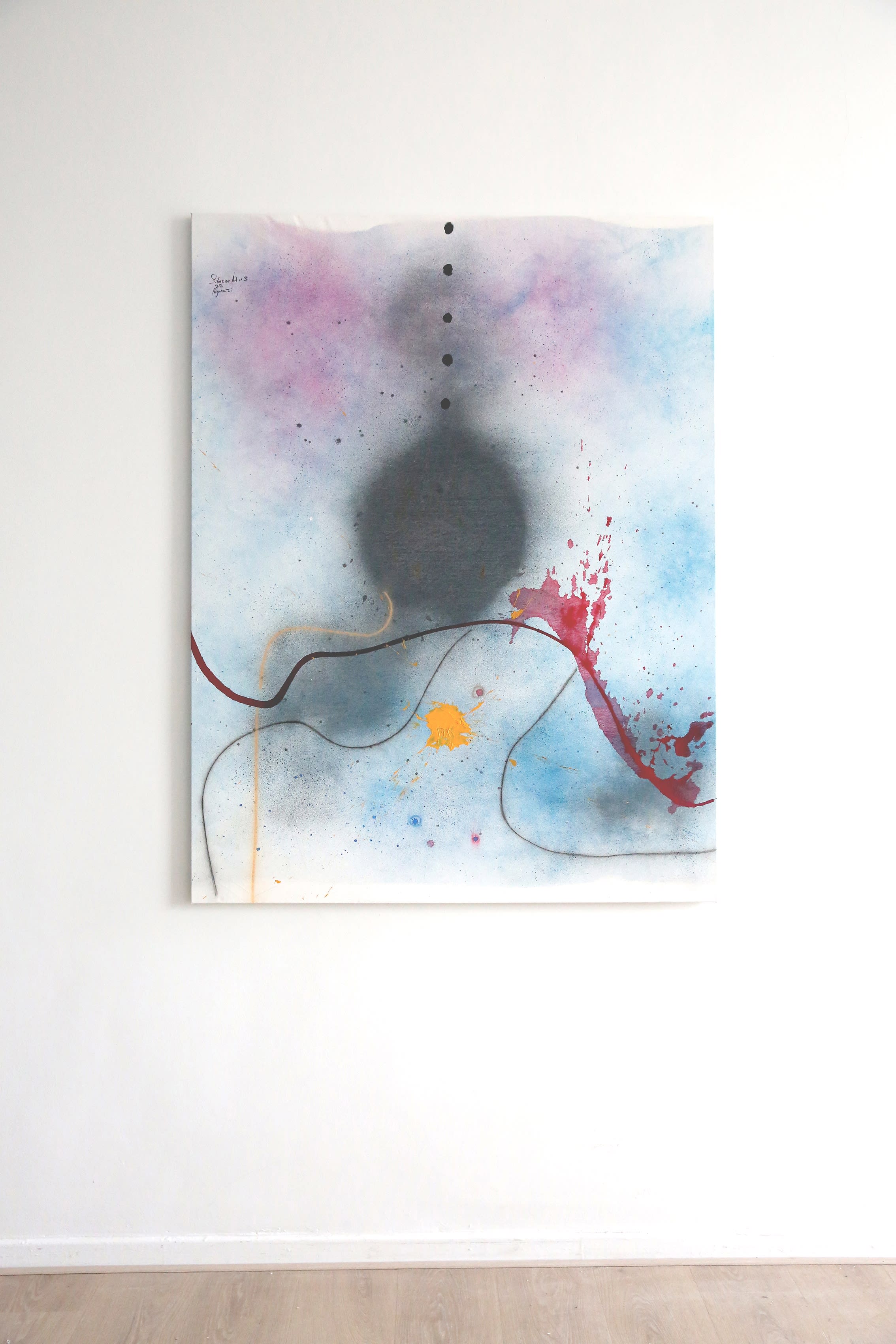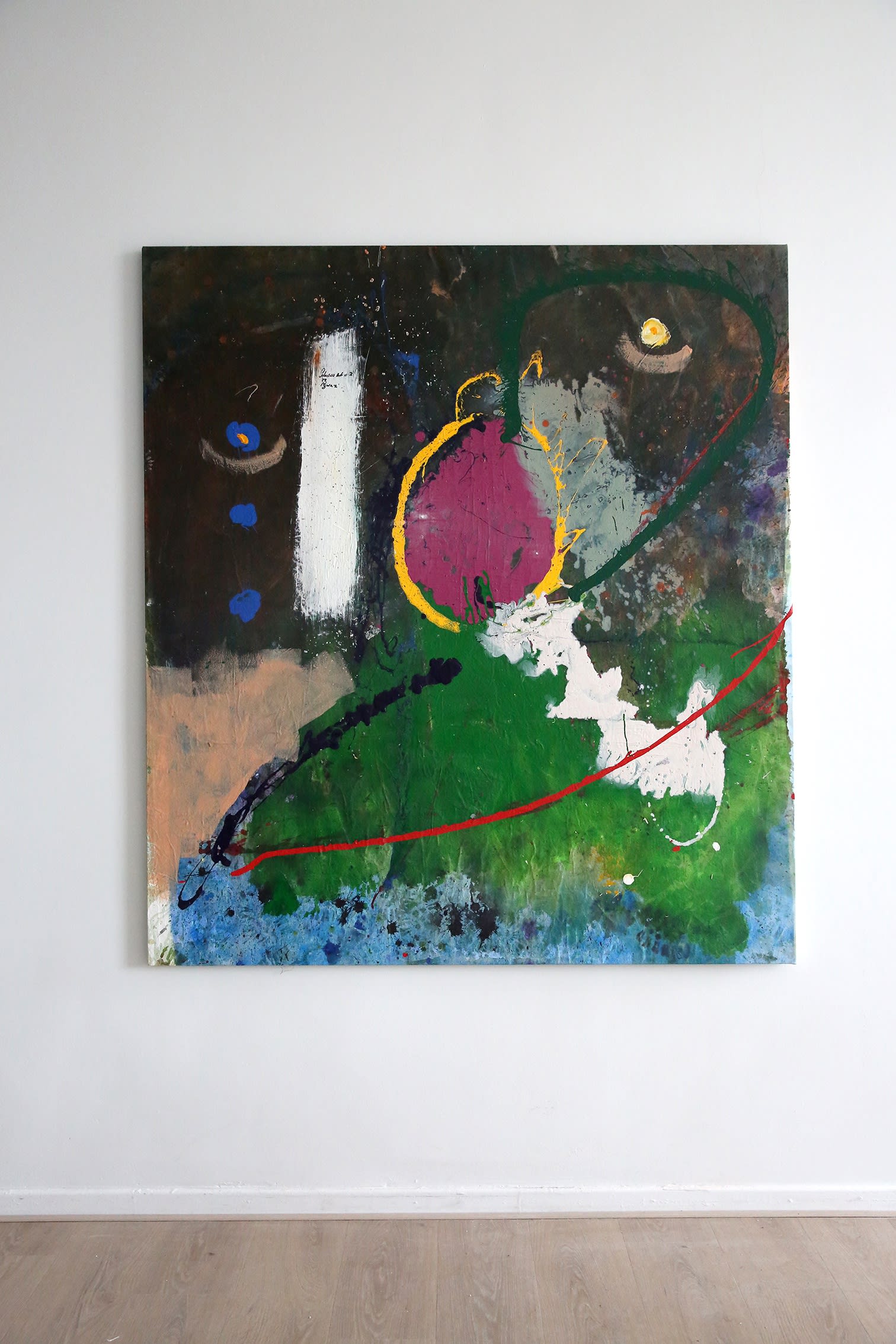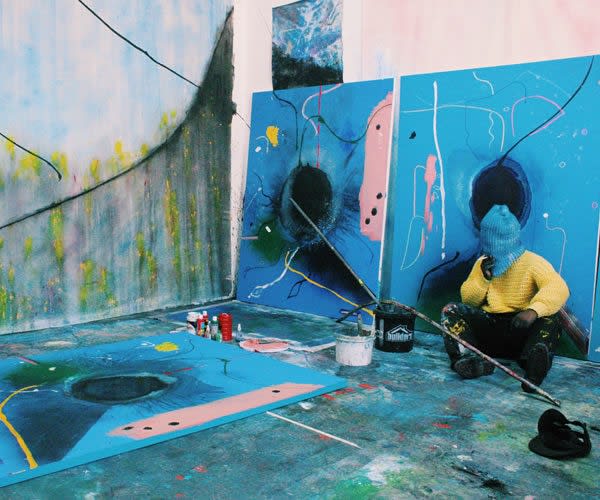
The artist in his studio. Image courtesy of the Noldor Residency.
Braille is a written language devised for the blind, the characters represented by patterns of raised dots which are known and felt with the fingertips. Tactile, haptic, sensuous, it is a language of the body, a Nietzschean ‘physiological thought’. Like any other language system, Braille is an abstraction. It is synaesthesic, a blended compound, part logic, part sensation.
Listening to Sibusiso Ngwazi in his studio in the industrial district of Salt River, in Cape Town, the foil covered rooftop glistening, paintings stashed on the criss-cross of wooden beams, the dingy white walls lashed with colour – artworks in themselves – it is this sensation of being blindsided, the concussive contact – physical, visceral – seeming to come out of nowhere, that rings in the head. This is why the paintings read as a kind of braille, conditions, or states, that are sensate. It is not reason that dominates the atmosphere, but sensation. There are large paintings – a mix of royal, azure, ultramarine, cerulean – lashed with yellows, whites, reds, black. Another series is ruled by beige that echoes the Namibian desert the artist visited in 2022, in which inscrutable forms remain richly visible. ‘Life is like a line, not a straight line, but one that flows like water’, the artist says. It is unsurprising, in the middle of a desert, that Ngwazi dreams of being underwater. Desert and ocean are commonly merged in our psyche and our poetics. The dream structure is an ocean, psychoanalysis tells us. As is the desert, a world composed of eddies and flows.
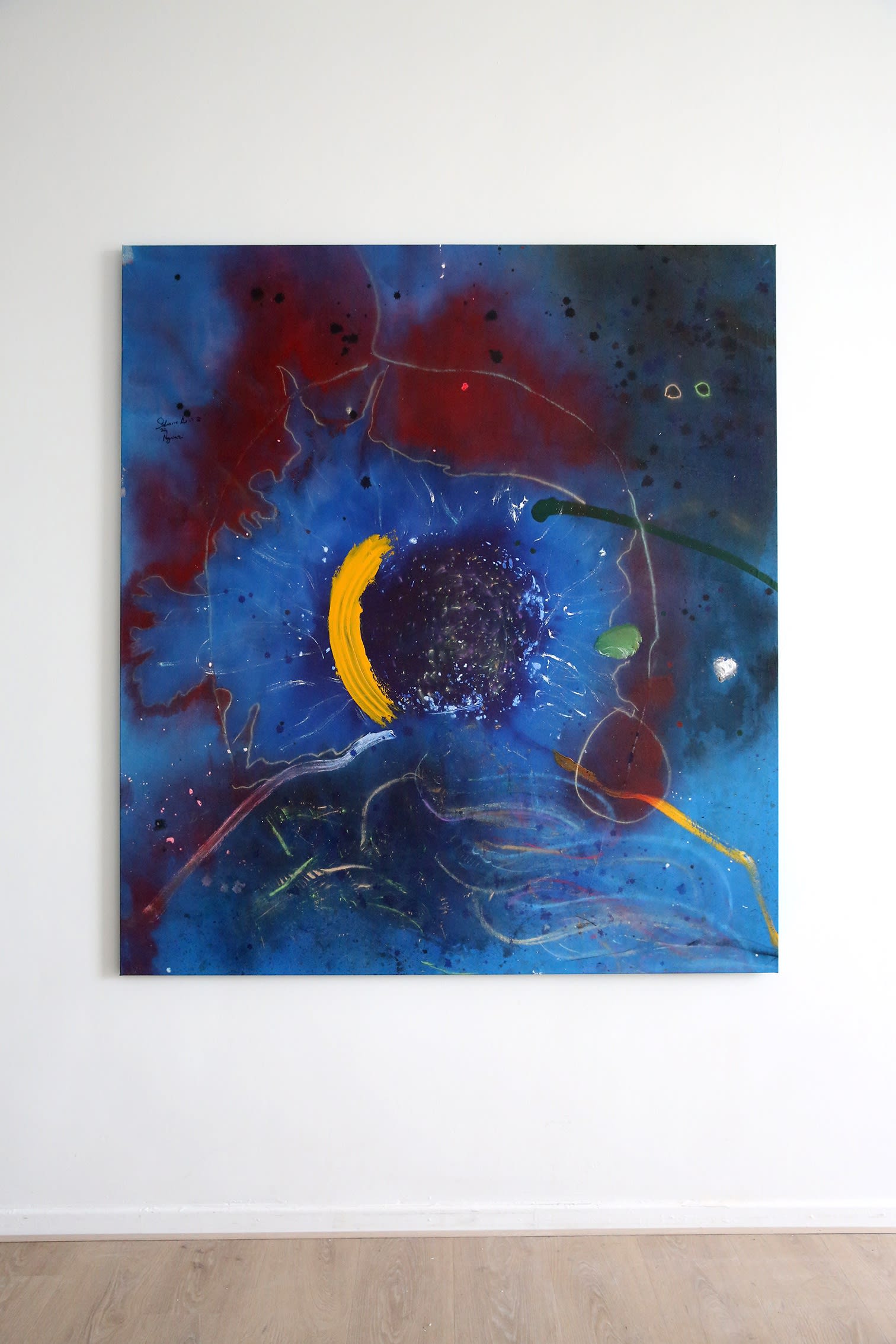
Sibusiso Ngwazi, "Come midnight", 2022. Mixed media on canvas. 180 x 162 cm
If Paul Klee’s remark leaps to mind – ‘a drawing is simply a line going for a walk’ – it is because it speaks to the dynamism built into abstract painting. That Ngwazi begins a painting while masked, so the hand, undirected by the eye, assumes the burden of choreography, reveals the artist’s adoration for instinct, drawing as an action-painting, as some Heraclitean flux. It is not the eye that takes the line for a walk, but the body.
‘My intention is not to understand the stroke. I hide my eyes, do the stroke, then, in the middle of the painting I remove the mask’. Artists pursue any number of strategies to outwit themselves, to override overthinking. For Ngwazi, blindness is integral to creating. When the paintings are revealed, half-way through the process, ‘there is a surprise – a new world’. Is Ngwazi a mariner, intrigued by uncharted territories? A mapmaker for an unknown world? A blind man in a world of the narrowly sighted? It certainly seems so. ‘I create a system driven by emotion’, he says. ‘System’ is a curious description, ‘a system driven by emotion’, more so. Does he believe, after Sigmund Freud and Jacques Lacan, that the unconscious possesses a structure? Can one speak of an emotional language that is as gnomic as it is decipherable? Here we return to Braille, meaning as both interpretation and ‘subconscious sensing’. Here, moreover, the desert, a central theme, as is the oceanic, once again impresses upon us the realisation that form is everywhere, and everywhere liquid and atomic, despite our yearning for fixity. ‘The texture of the desert is like a human skin’, says Ngwazi – ‘It is sensual. It has no eye’.
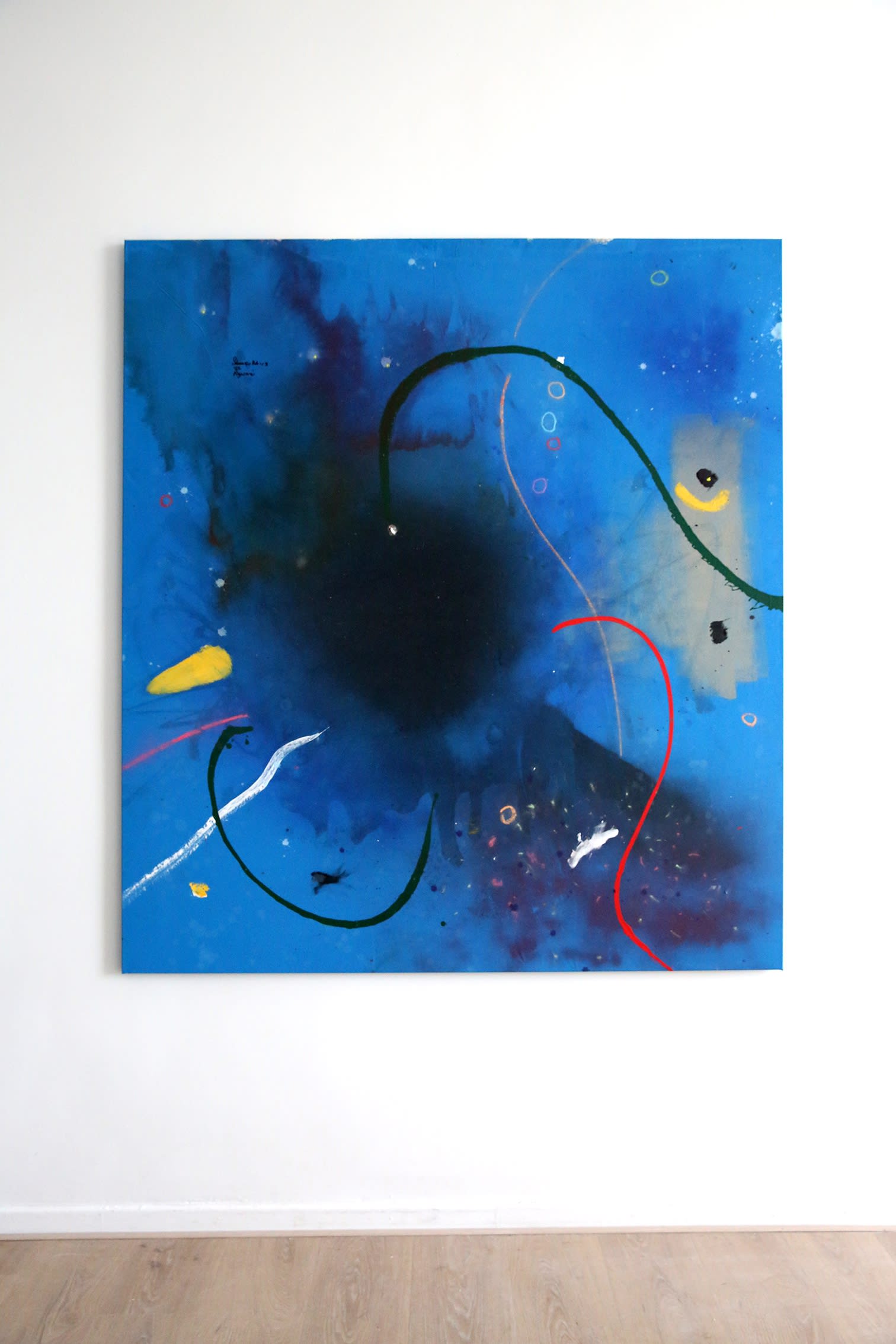
Sibusiso Ngwazi, "Corpus Christ", 2022. Mixed media on canvas. 180 x 162 cm
Perhaps because a desert will not return our gaze, because it is boundless, or, because it triggers abstract constructions that refuse any desire for containment? Once again, Paul Klee returns. His great inspiration was not the Namib Desert but the vivid streets and walls of Tunisia, which prompted him to declare that ‘colour and I are one’. How often we forget the immense influence of Africa on the likes of Klee, Picasso, Rimbaud. And now, from the mouth of a black African artist – Sibusiso Ngwazi – I hear the following: ‘When Miro and Malevich died, God made me’. Influence is reciprocal. South and north interpenetrate. Nietzsche described himself as a ‘hyperborean’, a lover of the sun who comes from the north. His declared Bizet’s opera, Carmen, to be far greater than any work by Wagner, because it was more sensuous, more passionate, more ‘African’.
In the prejudicial desire to nullify the immense influence of Africa on western art, we forget that geopolitics is infinitely more complex. That Ngwazi can acknowledge Miro and Malevich as his birth-right, reveals the greater openness of the artist. That his paintings are most distinctly influenced by Miro is, perhaps, self-evident. ‘I try to apply colours like words that shape poems, like notes that shape music’, says Miro. Once again, we return to some synesthesic architecture.
Sibusiso Ngwazi, "Je suis", 2022. Mixed media on canvas. 160 x 122 cm
‘I try to apply colours like words that shape poems, like notes that shape music’, says Miro. Once again, we return to some synesthesic architecture. Here we have entered the realm of similitude – like. No meaning is ever intrinsic, it is always aggregative. In Ngwazi’s paintings, it is this associative yearning that impels us. We venture into his paintings, as though upon an ocean, ‘trackless and unexplored’. There, in the shapeless-yet-shaping midst of a painting, we find our own coordinates.
Because no form is ever quite structured – circular form reads more like an iridescent blob, a line as something lambently inarticulate – reaffirms the artist’s love for a shaping shapelessness. At twenty-four, Sibusiso Ngwazi is a shining light. In entering the world blind, like a new-born child, he tells us of how little we are truly able to contain, see, or understand. It is not ignorance he champions, but ‘wonder’.
‘There is a freedom is wearing a mask’, he says, ‘when we remove the mask there is no more freedom’. Perhaps. Perhaps not. Our vision of the world is not as relentlessly objectifying as we assume it to be. In fact, our lives are saccadic, caught always ‘between two or more phases of fixation in the same direction’. As such, sight is better understood as pulsed – a pulsation – more a reverberatory thrumming. This is the quality of sight which Ngwazi’s paintings afford the viewer.
They allow us to sense the throb of life, its fleeting yet also densely sensate nature. In a second-hand bookshop in the middle of the South African desert – the Karoo – I stumbled upon an abridged collection of John Ruskin’s essays. We know him as the great champion of William Turner, the first great abstract artist.
Sibusiso Ngwazi, "Evening date III", 2022. Mixed media on canvas. 180 x 163 cm
But it was not Ruskin’s reflections on Turner that drew me irresistibly, but his reflection, ‘Of Truth of Space’, in which he notes that ‘nature is never distinct and never vacant, she is always mysterious, but always abundant; you always see something, but you never see all’. This is the sine qua non of abstraction. That he penned these thoughts in the 1830s is all the more remarkable.
Long before Modernism, Ruskin understood the deceit of knowledge, the death of the Idea, the irrepressible power of the emotions – art as a psychic geography. When Ngwazi remarks that ‘When Miro and Malevich died, God made me’, he should have included John Ruskin. As the great art writer notes, ‘Not one line out of the millions there is without meaning, yet there is not one which is not affected and disguised by the dazzle and indecision of distance. No form is made, and yet no form is unknown’.
About the author
Bruno Claessens



